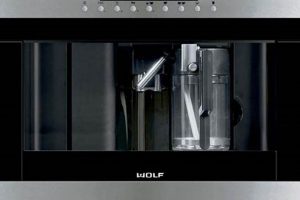These specialized appliances are engineered to produce consistently high-quality coffee in environments with significant demand, such as restaurants, cafes, offices, and hotels. Operating with minimal human intervention after initial setup, they grind beans, brew coffee, and often froth milk at the touch of a button. Consider a busy cafe needing to serve hundreds of cups of coffee daily; these machines ensure speed and uniformity.
Their significance stems from their ability to increase efficiency, reduce labor costs, and maintain a consistent product, regardless of the operator’s skill level. Historically, these machines have evolved from simple automated brewers to sophisticated systems with features like self-cleaning cycles, programmable settings, and remote monitoring capabilities. This evolution reflects a growing need for streamlined operations and higher standards in the beverage industry.
The following sections will delve into the key features, operational principles, selection criteria, and maintenance practices associated with these essential pieces of equipment, offering a detailed understanding of their role in contemporary commercial settings.
Tips for Optimizing Commercial Automatic Coffee Machine Utilization
The following tips aim to enhance the efficiency, longevity, and overall performance of commercial automatic coffee machines, ultimately improving the quality and consistency of the coffee served.
Tip 1: Water Quality is Paramount. Utilize a water filtration system appropriate for the specific water hardness levels in the locale. Minerals in unfiltered water can cause scale buildup, impacting the machine’s heating elements and overall performance. Periodic water testing is recommended.
Tip 2: Consistent Bean Selection. Maintain a consistent bean selection and storage protocol. Changes in bean type or freshness will necessitate adjustments to grinder settings and brewing parameters to ensure optimal extraction and flavor profile. Invest in airtight containers for bean storage.
Tip 3: Regular Cleaning Cycles are Essential. Adhere to the manufacturer-recommended cleaning schedule. Milk residue and coffee oils can accumulate, affecting taste and potentially causing mechanical issues. Implement a daily backflushing routine.
Tip 4: Calibrate the Grinder. Periodically calibrate the grinder to ensure consistent particle size. Inconsistent grinding can lead to under-extraction (sour taste) or over-extraction (bitter taste). Consult the machine’s manual for proper calibration procedures.
Tip 5: Monitor Brewing Parameters. Regularly monitor brewing parameters such as brew time and water temperature. Deviations from optimal settings can indicate underlying issues or require recalibration. Use a timer and thermometer to check accuracy.
Tip 6: Scheduled Maintenance is Crucial. Implement a scheduled maintenance program with a qualified technician. Preventative maintenance can identify and address minor issues before they escalate into costly repairs. Document all maintenance activities.
Tip 7: Train Staff Thoroughly. Ensure all staff members are properly trained on the machine’s operation, cleaning procedures, and troubleshooting techniques. Proper training minimizes user error and maximizes machine lifespan.
Adhering to these guidelines will contribute to the long-term performance and reliability of the equipment, ensuring consistent coffee quality and minimizing downtime.
The subsequent sections will address specific aspects of commercial automatic coffee machine technology, from selection criteria to troubleshooting common issues.
1. Brewing Capacity
Brewing capacity, in the context of commercial automatic coffee machines, refers to the maximum volume of coffee the machine can produce within a specific time frame, typically measured in cups per hour. This parameter directly impacts the machine’s suitability for different commercial environments. A high-volume establishment, such as a busy airport cafe, necessitates a machine with a significantly larger brewing capacity compared to a smaller office break room. Inadequate brewing capacity can lead to unacceptable wait times, dissatisfied customers, and lost revenue. Conversely, an over-specified capacity results in unnecessary capital expenditure and potentially higher energy consumption. Therefore, precise assessment of projected demand is critical.
The selection of an appropriate brewing capacity is not solely determined by peak demand. Factors such as the consistency of demand throughout the day, the availability of multiple machines, and the type of coffee beverages offered influence the optimal capacity. For example, a restaurant that experiences high coffee demand only during breakfast hours may require a machine with a large brewing capacity for a limited duration. Conversely, an office environment with steady coffee consumption throughout the workday might benefit from a machine with a moderate brewing capacity but high energy efficiency. Furthermore, the machine’s ability to consistently deliver quality coffee at its maximum capacity should be a primary consideration. Some machines may exhibit a decline in brewing quality when operating at or near their maximum capacity, thereby negating the benefits of a high brewing capacity.
In summary, brewing capacity is a fundamental attribute of commercial automatic coffee machines that directly influences operational efficiency, customer satisfaction, and overall cost-effectiveness. A comprehensive understanding of brewing capacity, coupled with a thorough analysis of specific operational requirements, is crucial for selecting the appropriate equipment and maximizing its performance. Failure to adequately consider brewing capacity can result in significant operational inefficiencies and diminished profitability.
2. Operational Efficiency
Operational efficiency, when applied to commercial automatic coffee machines, signifies the machine’s ability to produce high-quality coffee consistently and quickly while minimizing waste and resource consumption. It is a multifaceted concept that encompasses factors such as speed, reliability, ease of use, and cost-effectiveness. Maximizing operational efficiency is paramount for businesses seeking to optimize their coffee service, reduce labor costs, and enhance customer satisfaction.
- Automated Processes and Speed
Commercial automatic coffee machines streamline the brewing process through automation. Processes such as grinding, tamping, brewing, and milk frothing are executed automatically, significantly reducing the time required to prepare each beverage. This speed is crucial in high-volume environments, allowing staff to serve more customers in a shorter time frame, minimizing wait times, and maximizing revenue generation. An example of real-life impact is that a machine with faster brewing cycles can handle peak morning rushes more effectively, reducing bottlenecks and ensuring a smooth flow of service.
- Reduced Labor Costs
The automation inherent in commercial automatic coffee machines directly contributes to reduced labor costs. Unlike manual espresso machines, these devices require minimal operator intervention. This allows staff to focus on other essential tasks, such as customer service or food preparation. A real-world scenario involves a cafe deploying an automatic machine, which can then reallocate baristas to enhance customer interaction, thereby improving overall customer experience and potentially increasing sales. The machine can handle the brewing process with less direct labor involvement, optimizing staffing levels and reducing payroll expenses.
- Consistency and Quality Control
Operational efficiency includes maintaining consistent coffee quality. These machines are programmed to deliver precise measurements and brewing parameters, ensuring each cup meets established standards. Consistent quality is essential for building customer loyalty and brand reputation. A coffee chain, for example, relies on automatic machines to deliver a uniform taste experience across all locations, solidifying brand identity and meeting customer expectations. The elimination of human error in brewing leads to predictable, repeatable results, enhancing customer satisfaction.
- Minimizing Waste and Resource Consumption
Efficient operation also encompasses minimizing waste of coffee beans, water, and energy. Commercial automatic coffee machines can be programmed to dispense precise amounts of coffee and water, reducing waste from over-pouring or inaccurate measurements. Some models also incorporate energy-saving features, such as automatic shut-off and insulated boilers, reducing energy consumption during periods of low usage. An example of this is a hotel using a machine with portion control which is helping reduce coffee bean waste and lower its utility bills.
In summary, operational efficiency is a critical performance metric for commercial automatic coffee machines. The aspects of automated processes, reduced labor, consistent product, and resource savings contribute to improved business outcomes. Businesses benefit through reduced costs, increased revenues, and enhanced customer satisfaction. Therefore, when selecting a commercial automatic coffee machine, careful consideration should be given to features that maximize operational efficiency and contribute to long-term success. Prioritizing efficiency supports a sustainable, profitable, and customer-centric coffee service.
3. Maintenance Requirements
Effective maintenance is essential for ensuring the consistent operation, longevity, and hygiene of commercial automatic coffee machines. These machines represent a significant capital investment, and proper maintenance protocols are crucial for maximizing their return on investment and avoiding costly downtime. Neglecting maintenance can lead to decreased coffee quality, equipment malfunction, and potential health code violations.
- Regular Cleaning of Brewing Components
The brewing components, including the brew group, dispensing spouts, and bean hoppers, require routine cleaning to remove coffee residue and oils. Failure to clean these parts regularly can result in the buildup of rancid oils, affecting the taste of the coffee and potentially clogging the machine’s internal mechanisms. For example, backflushing the brew group daily is a common practice to remove accumulated coffee grounds. Specific cleaning agents formulated for coffee machines should be used to avoid damaging the machine’s components. Adherence to the manufacturer’s recommended cleaning schedule is critical.
- Descaling and Water Filtration Maintenance
Mineral buildup from water can lead to scale formation within the boiler and heating elements, reducing efficiency and potentially causing permanent damage. Descaling the machine regularly, based on water hardness levels, is vital. Implementing a water filtration system reduces mineral content and minimizes the need for frequent descaling. Replacing water filters according to the manufacturer’s guidelines is essential for maintaining optimal water quality and machine performance. Failure to address scale buildup can result in reduced brewing temperature and increased energy consumption.
- Inspection and Replacement of Seals and Gaskets
Seals and gaskets throughout the machine, including those in the brew group, water lines, and steam wand, are subject to wear and tear. Regular inspection of these components is necessary to identify leaks or signs of degradation. Prompt replacement of worn seals and gaskets prevents water leakage, maintains optimal pressure, and ensures proper machine function. A damaged gasket in the brew group, for instance, can lead to loss of pressure during brewing, resulting in under-extracted and weak coffee.
- Preventative Maintenance by Qualified Technicians
Scheduled preventative maintenance by a qualified technician is crucial for identifying and addressing potential issues before they result in equipment failure. Technicians can inspect internal components, adjust settings, and perform necessary repairs or replacements. Regular maintenance contracts often include cleaning of internal components, calibration of grinding mechanisms, and testing of safety features. Skipping professional maintenance can lead to more significant and costly repairs down the line.
The elements of component cleaning, descaling, seal maintenance, and technician support are all important to ensuring the reliable, long-term function of commercial automatic coffee machines. Proper attention to these maintenance requirements translates to a higher-quality product, longer equipment life, and reduced operational costs. Inadequate maintenance, conversely, can rapidly diminish performance and increase overall expenses.
4. Technological Integration
Technological integration significantly impacts the functionality and efficiency of commercial automatic coffee machines. Modern iterations extend beyond basic automation, incorporating features such as cloud connectivity, data analytics, and advanced sensor technologies. These integrations directly influence operational efficiency, predictive maintenance, and the overall customer experience. For instance, remote monitoring systems enable operators to track machine performance in real-time, identifying potential issues before they escalate into equipment failures. Data analytics provide insights into coffee consumption patterns, allowing for optimized inventory management and menu planning. The result is a system that is not only capable of producing coffee automatically but also of continuously improving its own performance and adapting to changing business needs.
The practical applications of this integration are diverse. Consider a coffee shop chain that utilizes a network of connected machines. The central management system can remotely update brewing parameters across all locations, ensuring consistent coffee quality regardless of geographic location. Sensor technologies within the machines monitor water quality, bean levels, and brewing temperature, automatically adjusting settings to maintain optimal performance. Furthermore, predictive maintenance algorithms analyze machine data to forecast potential component failures, allowing for proactive scheduling of repairs and minimizing downtime. These systems also facilitate cashless payment options and loyalty programs, enhancing the customer experience and driving revenue growth.
In summary, technological integration transforms automated coffee machines from simple appliances into sophisticated systems capable of delivering measurable improvements in efficiency, quality, and profitability. The challenges lie in ensuring data security, maintaining software compatibility, and providing adequate training to staff. However, the potential benefits are substantial, making technological integration a critical factor in the evolution and adoption of commercial automatic coffee machines. Future advancements are likely to focus on enhanced artificial intelligence and machine learning capabilities, enabling even greater levels of automation and personalization.
5. Cost Effectiveness
The cost effectiveness of commercial automatic coffee machines represents a multifaceted consideration, influencing purchasing decisions and operational strategies in diverse commercial settings. It is not solely defined by the initial investment but encompasses a complex interplay of factors including upfront costs, operational expenses, maintenance requirements, labor savings, and revenue generation potential. A thorough understanding of these interconnected variables is crucial for determining the long-term financial viability of deploying such equipment. For example, a seemingly inexpensive machine with high maintenance demands and limited lifespan may ultimately prove more costly than a higher-priced, more durable model.
Key aspects of cost effectiveness include labor savings, consistency of product, and waste reduction. These machines, by automating the brewing process, reduce reliance on skilled baristas, lowering labor expenses. Furthermore, the consistent quality of the coffee produced minimizes waste and ensures customer satisfaction, fostering repeat business. Consider a large office environment where a fully automatic machine can produce hundreds of consistently brewed cups per day with minimal staff intervention. This reduces the need for dedicated coffee service personnel, leading to substantial cost savings over time. Also, the reduction in coffee bean waste, compared to manual brewing methods, further contributes to long-term cost efficiency. The cost of repair and preventative maintenance should also be factored in and compared to the cost of replacing a unit.
In conclusion, the cost effectiveness of these machines is not solely about price but about the total cost of ownership over the equipment’s lifespan. It necessitates a comprehensive analysis of initial investment, operational expenses, labor savings, potential revenue generation, and maintenance considerations. While the upfront cost may be a significant factor, the long-term savings and increased efficiency offered by commercial automatic coffee machines often outweigh the initial investment, provided a careful assessment of the specific needs and operational context is conducted. Neglecting this holistic perspective can lead to suboptimal purchasing decisions and diminished profitability.
Frequently Asked Questions
The following questions address common inquiries and concerns regarding the selection, operation, and maintenance of commercial automatic coffee machines.
Question 1: What is the typical lifespan of a commercial automatic coffee machine?
The average lifespan ranges from five to ten years, contingent on usage volume, maintenance practices, and machine quality. Regular cleaning, descaling, and preventative maintenance significantly extend the operational life.
Question 2: What is the recommended water hardness level for optimal machine performance?
Water hardness should ideally be maintained between 50-85 parts per million (ppm). Excessive hardness leads to scale buildup, while excessively soft water can be corrosive. Water filtration systems are recommended to achieve optimal levels.
Question 3: How frequently should the machine undergo professional servicing?
Professional servicing is advised at least annually, or more frequently for high-volume operations. Qualified technicians can inspect internal components, calibrate settings, and address potential issues before they escalate.
Question 4: What are the common causes of inconsistent coffee flavor?
Inconsistent flavor can stem from variations in bean quality, grinder calibration, water temperature, or brewing time. Consistent bean sourcing, regular grinder adjustments, and adherence to recommended brewing parameters are crucial.
Question 5: What is the best method for cleaning milk frothing systems?
Milk frothing systems require daily cleaning to prevent milk residue buildup. Dedicated milk system cleaners should be used according to the manufacturer’s instructions. Disassembling and cleaning individual components is also necessary periodically.
Question 6: How can downtime be minimized during peak service hours?
Downtime can be minimized through preventative maintenance, staff training, and readily available spare parts. Establishing a troubleshooting protocol and maintaining a backup machine are also beneficial.
These answers provide a foundation for understanding the practical considerations surrounding commercial automatic coffee machines. Proper planning and execution of these aspects contribute significantly to operational efficiency and customer satisfaction.
The subsequent section will delve into troubleshooting common problems encountered with commercial automatic coffee machines and offer practical solutions.
Conclusion
This exploration of commercial automatic coffee machines has illuminated their crucial role in modern commercial settings. These machines offer consistent quality, increased efficiency, and reduced labor costs, making them indispensable for businesses requiring high-volume coffee service. The multifaceted aspects of brewing capacity, operational efficiency, maintenance needs, technological integrations, and cost-effectiveness collectively dictate their suitability and overall value.
The decision to invest in these specialized appliances requires careful consideration of operational demands and long-term financial implications. Properly selected and maintained machines represent a strategic asset, contributing to enhanced customer satisfaction and improved profitability. Ignoring the complexities of their functionality and upkeep can lead to operational inefficiencies and financial losses. The future of commercial coffee service will be shaped by continued advancements in these technologies, emphasizing the importance of informed decision-making and proactive maintenance practices.







